Main menu
Common skin conditions

NEWS
Join DermNet PRO
Read more
Quick links
Spa pool folliculitis — extra information
Spa pool folliculitis
Authors: Dr Amanda Oakley, MBChB FRACP, Dermatologist, Hamilton, New Zealand, 1999
Update: Zena Al-Ani, Medical Student, University of Auckland, Auckland, New Zealand; Honorary A/Prof Paul Jarrett, Dermatologist, Middlemore Hospital and Department of Medicine, University of Auckland, Auckland, New Zealand. Copy edited by Gus Mitchell. May 2021
Introduction Demographics Causes Clinical features Variation in skin types Complications Diagnosis Differential diagnoses Treatment Outcome
What is spa pool folliculitis?
Spa pool folliculitis, also called hot tub folliculitis or pseudomonas folliculitis, is a Gram-negative bacterial infection of hair follicles acquired during exposure to hot water such as in spa pools, hot tubs, and jacuzzis.
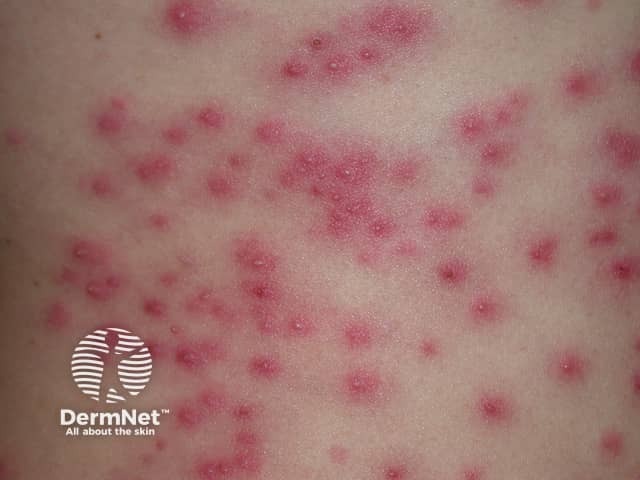
Pseudomonas folliculitis
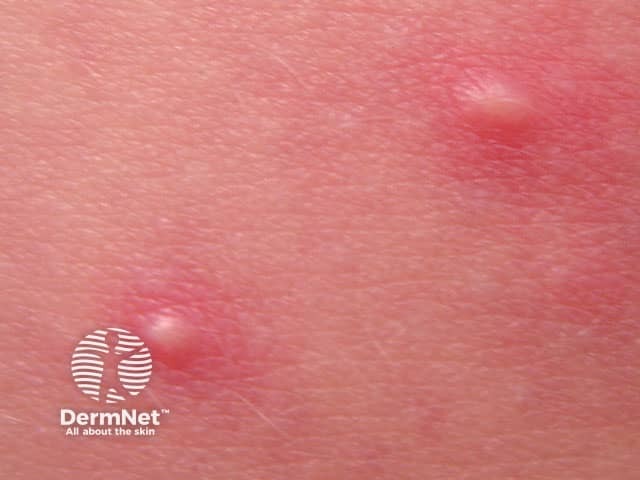
Spa pool folliculitis

Spa pool folliculitis
Who gets spa pool folliculitis?
Spa pool folliculitis can affect the skin of anyone who has been exposed to warm wet environments. Examples of potential exposures include spa pools, hot tubs, jacuzzi, warm water swimming pools, rehabilitation pools, floatation tanks, whirlpools, floatation aids in swimming pools, contaminated toys in the family bath tub, wet suits, and industrial closed-loop water recycling systems. The longer the duration and frequency of exposure the greater the risk.
Spa pool folliculitis predominantly affects females. All age groups and races can develop the condition following exposure. Immunocompromised patients may be predisposed to rapid skin colonisation by Gram-negative bacteria. However, not all exposed individuals develop the infection, perhaps reflecting the duration of exposure, sex, and skin microflora.
What causes spa pool folliculitis?
Spa pool folliculitis is due to an opportunistic bacterial infection of the skin by Pseudomonas aeruginosa or, less commonly, Aeromonas hydrophila. These ubiquitous Gram-negative bacteria can survive in warm water, even when adequately chlorinated, because of the formation of a biofilm on the tub surface or within the piping system. Contamination is more common if the water is inadequately treated or organic material, such as skin, is present.
It is hypothesised that water absorption into the stratum corneum increases proportionately with the time submerged in water, enhancing permeability to bacteria.
What are the clinical features of spa pool folliculitis?
Spa pool folliculitis presents as a sudden eruption of scattered red macules that evolve into papules and pustules centred on hair follicles. The onset is generally between 8 hours and five days after exposure. Areas of skin covered by swimwear, such as the buttocks, are most prone to develop the rash. Itch, pain, and a burning sensation are common. Swollen tender lymph glands may develop.
Pseudomonas aeruginosa can also cause ‘hot hand-foot syndrome’ (hot-foot syndrome) presenting as tender or painful red nodules on the palms and/or pressure-bearing areas of the soles of the feet, particularly in children, which may develop at the same time as the folliculitis.
Some people with spa pool folliculitis feel unwell, with the most common symptoms being malaise/fatigue, headache, low-grade fever, earache, sore throat, abdominal discomfort, nausea, vomiting, and diarrhoea.
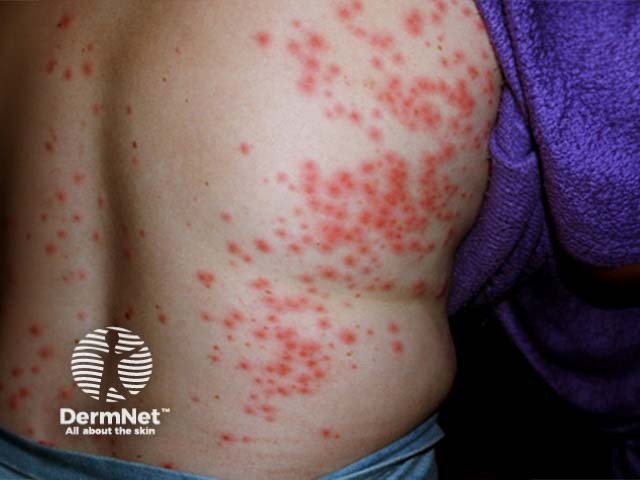
Spa pool folliculitis


Spa pool folliculitis
How do clinical features vary in differing types of skin?
The erythema of spa pool folliculitis may be difficult to appreciate in skin of colour. Postinflammatory hyperpigmentation is common in darker skin types.
What are the complications of spa pool folliculitis?
How is spa pool folliculitis diagnosed?
Spa pool folliculitis is usually diagnosed based on the history of exposure and the clinical features.
Gram stain of a smear taken from pustules will show Gram-negative (pink/red) rods. Culture and antibiotic sensitivities should be reported as isolates may show resistance to multiple antibiotics.
Skin biopsy of the folliculitis is not usually required. Histology is morphologically identical to malassezia folliculitis pathology without the yeast. Biopsy of the hot hand-foot syndrome nodules is reported to show neutrophils around blood vessels, eccrine sweat glands, and other skin adnexae in the dermis and subcutis.
The source of infection may be confirmed by microbiological assessment of the water, pool surfaces, filter, and pipes.
What is the differential diagnosis for spa pool folliculitis?
- Other infective forms of folliculitis
- Non-infective causes of a papulopustular eruption
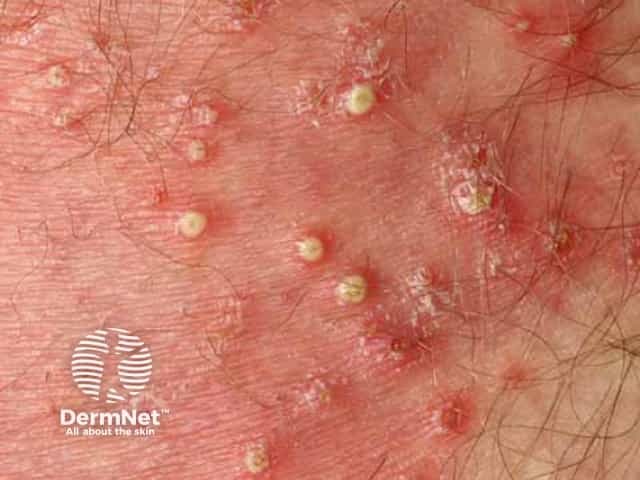
Superficial bacterial folliculitis

Malassezia folliculitis
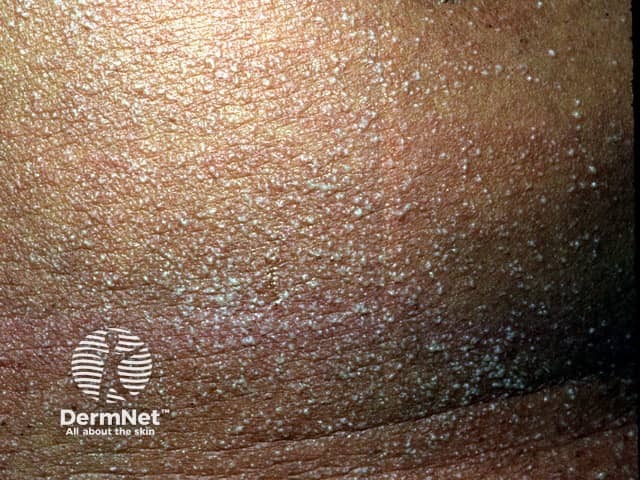
Miliaria
What is the treatment for spa pool folliculitis
Prevention
- Remove swimwear and shower after getting out of the warm pool
- Wash swimwear after use
- Regular maintenance and cleaning of the pool
General measures
Spa pool folliculitis is best treated by avoiding the source of infection. The responsible pool should be properly cleaned and disinfected.
A topical skin antiseptic and/or oral antibiotics may sometimes be required.
What is the outcome for spa pool folliculitis?
Spa pool folliculitis is usually self-resolving within 14 days without sequelae.
Recurrences may occur if the source of the infection is not identified and treated/avoided.
Bibliography
- Hewitt DJ, Weeks DA, Millner GC, Huss RG. Industrial pseudomonas folliculitis. Am J Ind Med. 2006;49(11):895-9. doi:10.1002/ajim.20391. PubMed
- Hogan PA. Pseudomonas folliculitis. Australas J Dermatol. 1997;38(2):93–4. doi:10.1111/j.1440-0960.1997.tb01117.x. PubMed
- Hyllestad S, Lange H, Guzman-Herrador B, et al. An outbreak of skin rash traced to a portable floating tank in Norway, May 2017. Euro Surveill. 2019;24(38):1900134. doi:10.2807/1560-7917.ES.2019.24.38.1900134 Journal
- Jacob JS, Tschen J. Hot tub-associated pseudomonas folliculitis: a case report and review of host risk factors. Cureus. 2020;12(9):e10623. doi:10.7759/cureus.10623. PubMed Central
- Lutz JK, Lee J. Prevalence and antimicrobial-resistance of Pseudomonas aeruginosa in swimming pools and hot tubs. Int J Environ Res Public Health. 2011;8(2):554–64. doi:10.3390/ijerph8020554. Journal
- Mulholland A, Yong-Gee S. A possible new cause of spa bath folliculitis: Aeromonas hydrophila. Australas J Dermatol. 2008;49(1):39–41. doi:10.1111/j.1440-0960.2007.00418.x. PubMed
- Olszewski AE, Karandikar MV, Surana NK. Aeromonas as a cause of purulent folliculitis: a case report and review of the literature. J Pediatric Infect Dis Soc. 2017;6(1):e1–3. doi:10.1093/jpids/piw073. PubMed Central
- Yu Y, Cheng AS, Wang L, Dunne WM, Bayliss SJ. Hot tub folliculitis or hot hand-foot syndrome caused by Pseudomonas aeruginosa. J Am Acad Dermatol. 2007;57(4):596–600. doi:10.1016/j.jaad.2007.04.004. PubMed
On DermNet
- Bacterial folliculitis
- Folliculitis
- Gram-negative folliculitis
- Pseudomonas skin infections
- Spa pool folliculitis images
Other websites
- Pseudomonas folliculitis — Medscape
